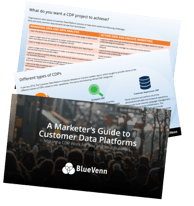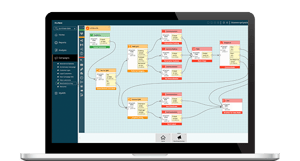
Although it faces some competition from the Scott Brinker Supergraphic, Gartner’s ‘Hype Cycle for Digital Marketing and Advertising’ is arguably the most awaited martech and adtech market visualization of the year. While the Supergraphic is one dimensional and doesn’t really say a lot about a product’s journey, the Hype Cycle plots the reality versus the myth of every technology wave.
Gartner is able, through its global presence and position of authority, to accurately measure the technology talking points of the moment (CDP, DMP, machine learning, etc.) and provide estimated timelines for these innovations to reach the stage where customers will start to see their maximum value. Similarly, the Hype Cycle will alert the market to anything that has hyped too far and predict its obseletion, i.e. that it will cease to be talked about and developed, before it reaches maturity.
The Gartner Hype Cycle is a simple line graph and bell curve that is then divided along the X axis into 5 segments: Innovation Trigger, Peak of Inflated Expectation, Trough of Disillusionment, Slope of Enlightenment, and finally Plateau of Productivity. The idea is to show the passage of a new form of technology, from the point where people become excited about it, to market saturation, to the point where its shine slightly fades in the eyes of its users.
That isn’t necessarily the end of the story, though. While some trendy technologies disappear, because they were more hype than substance, in many cases the fall will be followed by a renewed surge in interest. This will mark the point where the technology has become an accepted and valued mainstream business tool, either because it has been perfected or because the pretenders to its name – those who claimed to belong to the technology group but didn’t actually incorporate the key features and abilities of that group – have fallen by the wayside, leaving only genuinely valuable products on the market.
How do Customer Data Platforms stand up this year?
In 2018, the Customer Data Platform was at the top of the Peak of Inflated Expectation. It’s still in that section of the Hype Cycle (just), but is now entering a phase of decline and will soon slip into the Trough of Disillusionment. Those observing the cycle in isolation, without qualifying statements, might be forgiven for thinking that this is a period of uncertainty for CDP vendors, with chances of the technology becoming obsolete equaling those of it climbing back out of the trough and reaching a point of successful productivity via the Slope of Enlightenment. Not so!
Gartner itself states that the reason for the current state of disillusionment with the technology is that many customers are confused about what qualifies a data management system to be a CDP and what it should be used for. In fact, a Gartner survey showed that 50% of marketers who had deployed a CDP said it was their CRM (hint: they are two different technologies. If you don’t know the difference, you need to read this blog now.) The research and advisory firm believes that this confusion is due partly to companies being confounded by the saturation and variety of vendors, and partly to the feature overlap of CDPs with similar technology.
So, what is a CDP? The CDP Institute is regarded as a vendor-neutral authority on this form of technology, and in order to qualify for its certification as a ‘RealCDP’, a data management system must be able to:
- ingest data from any source
- capture full detail of ingested data
- store ingested data indefinitely (subject to privacy constraints)
- create unified profiles of identified individuals
- share data with any system that needs it.
A CRM can’t ingest data from or share it with any source (which a CDP can through APIs or bi-directional connectors), so that means the two shouldn’t be confused. It’s not just CRMs that have been calling themselves CDPs, though, many different products are pretenders to this title. That’s why this gradual descent from the Peak of Inflated Expectations is actually a good thing for those vendors whose product genuinely meets all of the above specifications.
A Marketer’s Guide to Customer Data Platforms eBook

Eventually (within the next 2-5 years, if Gartner is to be believed), the technology platforms that have loosely adopted the CDP acronym will start to fall away, whilst the CDP providers with better, more complete offerings will pull through, enabling the buying market to realise the value they hoped to gain from the technology when the hype began. At that stage, mass adoption will occur.
But 2-5 years is actually quite a short time to wait for CDPs to finally move to mass adoption in the Plateau of Productivity, defined as:
The real-world benefits of the technology are demonstrated and accepted. Tools and methodologies are increasingly stable as they enter their second and third generation. The final height of the plateau varies according to whether the technology is broadly applicable or benefits only a niche market.
To put this into context, the CDP is among just 4 technologies Gartner picks out this year as having “the capability to transform how marketers run their technology ecosystems”; of these 4, it is the only one that will mature in less than 5 years. In the meantime, buyers will need to be very prescriptive with their requirements and carefully consider a CDP purchase, since there is a competitive advantage to be gained from choosing the right vendor, as seen in our recent Customer Data Excellence survey.
CDPs are not a replacement technology, but in fact an enabler for other marketing automation and analytical solutions. A Gartner Analyst I spoke to recently referred to the CDP as the ‘connective tissue’ for many brands that have a martech stack that they cannot fully replace. The need for brands to become truly omnichannel is here, and the CDP provides the potential to act as middleware by funnelling more complete and trustworthy data to your execution, activation and orchestration technology platforms, thus piecing together all the fragmented data across the customer journey to enable marketers to create more consistent and personalized customer experiences. So, pick your CDP with care and you’ll find it will deliver everything you need it to.
BlueVenn Customer Data Platform demo

LIVE NEXT at: 10am EST / 3pm GMT on January 26, 2021
Find out how to make better use of your data. Register to find out how you can use customer analytics and real-time, omnichannel customer journey tools to create personalized and contextual customer experiences. In the session we’ll define how to:
- Use predictive analytics to make real-time decisions that positively affect the customer journey.
- Improve targeting of campaigns using customer segmentation and RFV analysis.
- Use real-time personalization to better engage customers.
- Integrate online and offline channels into the BlueVenn Customer Data Platform to create a true Single Customer View.











